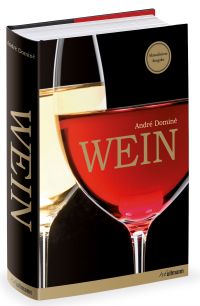When a wine book bears the simple title "Wine", the whole thing is to be understood programmatically: It's all about the whole. How is wine created? How is it grown and produced? From which grape varieties is it made? Where is it produced, how do the wines differ? Which wineries are recommendable? Finding answers to all these questions in a single work - that is a tall order. The Hamburg-born author André Dominé, who has lived in the South of France for years, has devoted himself intensively to these questions with his work entitled "Wine" since its first edition in 2000. A few weeks ago, the new edition of his book, which weighs over four kilograms and contains 944 pages, was published and has long since gained a reputation as a standard work on the subject. With all editions in 17 languages, it has a circulation of millions.
Although Dominé's name still stands as author above the short title, the work has long been the teamwork of renowned authors with outstanding reputations. Thus, 17 highly competent experts write for Dominé's work, including Wein-Plus author Wolfgang Faßbender, Eckhard Supp, David Schwarzwälder, Ulrich Sautter and Steffen Maus, to name but a few. Together with André Dominé, they have updated the thick book and in some cases revised it significantly - because the world of wine is turning fast. Above all, they have brought the chapters on Germany, Austria and Switzerland up to date, as well as many aspects of other countries. The reader can thus get a good, well-founded impression of the history and development of the wine-growing regions of the whole world. Holland, Denmark, Great Britain, Turkey, India, China and Japan are also covered, some in short chapters.
 The structure of the work, however, is still very similar to the first edition: the first 140 pages deal with the major topics such as the history of wine, the right choice, wine at table, the grape varieties of the world, cultivation and terroir, vine diseases, vineyard work as well as the basics of vinification, ageing and bottling. This is followed by 800 pages of the world's growing regions. 2,000 good photos by Armin Faber and Thomas Pothmann as well as 150 maps illustrate the compendium in a pleasant, informative way.
The structure of the work, however, is still very similar to the first edition: the first 140 pages deal with the major topics such as the history of wine, the right choice, wine at table, the grape varieties of the world, cultivation and terroir, vine diseases, vineyard work as well as the basics of vinification, ageing and bottling. This is followed by 800 pages of the world's growing regions. 2,000 good photos by Armin Faber and Thomas Pothmann as well as 150 maps illustrate the compendium in a pleasant, informative way.
Most of the topics, even within the growing regions, are dealt with on a double-page spread; only rarely do they cover four or more pages. This results in an overflowing variety of content, for which it is worthwhile to read in depth with other books. "Wine" is particularly suitable for providing a well-researched overview of a special growing region or topic. Due to the diversity and breadth of the topic, individual aspects are not always described completely or precisely in all details. In the large chapter on Germany, for example, only a few lines are provided on the increasingly important topic of organic wine, and there it is mostly about biodynamic cultivation. Moreover, its spiritual basis in Rudolf Steiner's philosophy is only incompletely described. In addition, mistakes in names and spellings crop up again and again, which is almost inevitable given the immense number of vintners and wineries mentioned. However, the selection of recommended wineries and their rating with a star system are quite successful. In detail, one can certainly discuss one or the other aspect here - for example, why Philipp Wittmann is the only winemaker in the German chapter whose work is explained on a double page, while wine legends like Angelo Gaja are only given a small box. But that's the way it is with wine. There will always be food for discussion. In this work it is no different.
But current topics such as the Leithaberg DAC in Austria, created in 2010, now find an appropriate place, as do developments in Bordeaux, the rise of Mallorcan wines or the success of German red wines. The chapters on the wine-growing regions are interspersed with boxes or double-page spreads on interesting facts such as glass production in Austria, cork production in Spain or barrique production in France. The index section includes a glossary, vintage recommendations for all wine nations, a bibliography, as well as a subject, place, person and winery index. So it is fun to leaf through the enormous yet easy-to-read volume with a glass of wine and discover something new again and again. Dominé and his authors have certainly fulfilled the programmatic claim of "wine". The price of 39.90 euros is still very moderate in comparison for such a comprehensive compendium - especially since the price of the printed book also includes the e-book, which can be downloaded from the internet using a code included in the printed work.
André Dominé
Wine
Updated and expanded new edition 2013
Verlag H.F. Ullmann, Potsdam
€ 39.90
ISBN: 978-3-8480-0182-9